K715
R&D Systems™ SUMO2 Conjugation Kit
Manufacturer: R&D Systems™
The price for this product is unavailable. Please request a quote
Content And Storage
Store the unopened product at -70° C. Use a manual defrost freezer and avoid repeated freeze-thaw cycles. Do not use past expiration date.
Related Products
Description
- Human Small Ubiquitin-like Modifier 2 (SUMO2), also known as Sentrin2 and SMT3B is synthesized as a 95 amino acid (aa), propeptide with a predicted 11 kDa
- SUMO2 contains a two aa C-terminal prosegment and an 18 aa N-terminal protein interacting region between aa 33-50
- Human SUMO2 shares 100% aa sequence identity with mouse SUMO2
- SUMO2 also has very high aa sequence identity with SUMO3 and SUMO4, 86% and 85%, respectively
- SUMO2 shares only 44% aa sequence identity with SUMO1
- SUMOs are a family of small, related proteins that can be enzymatically attached to a target protein by a post-translational modification process termed SUMOylation
- All SUMO proteins share a conserved Ubiquitin domain and a C-terminal diglycine cleavage/attachment site
- Following prosegment cleavage, the C-terminal glycine residue of SUMO2 is enzymatically attached to a lysine residue on a target protein
- In humans, SUMO2 is conjugated to a variety of molecules in the presence of the SAE1/UBA2 SUMO-activating (E1) enzyme and the UBE2I/Ubc9 SUMO-conjugating (E2) enzyme
- In yeast, the SUMO-activating (E1) enzyme is Aos1/Uba2p
- Because of the high level of aa sequence identity most studies report effects of SUMO2/3
- For example, post-translational addition of SUMO2/3 was shown to modulate the function of ARHGAP21, a RhoGAP protein known to be involved in cell migration
- Other reports indicate that the SUMOylation with SUMO2/3, but not SUMO1, may represent an important mechanism to protect neurons during episodes of cerebral ischemia
- However, studies suggest that SUMO2/3 expression is regulated in an isoform-specific manner since oxidative stress downregulated the transcription of SUMO3 but not SUMO2.






